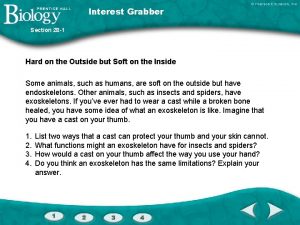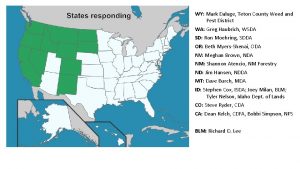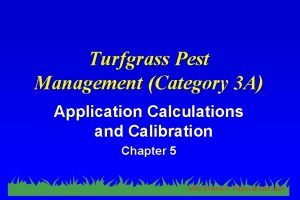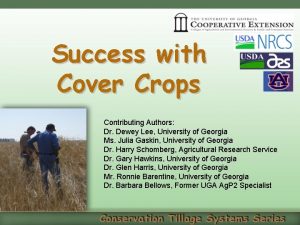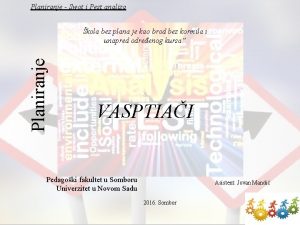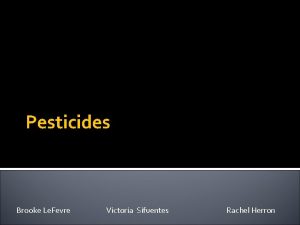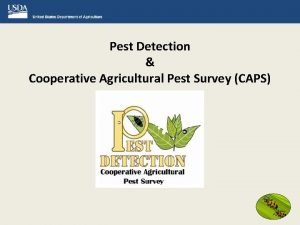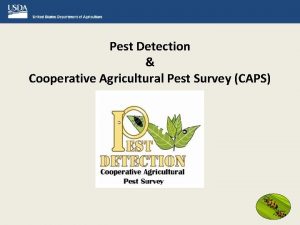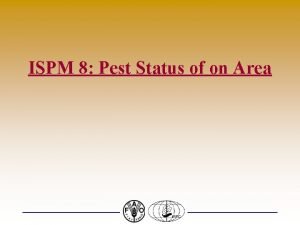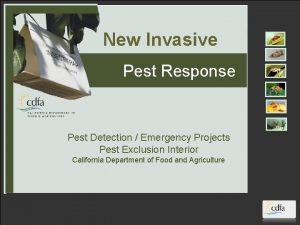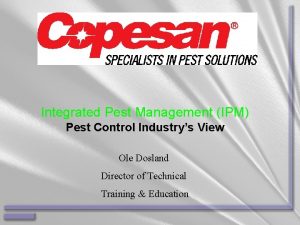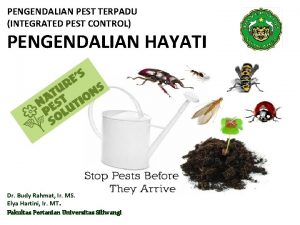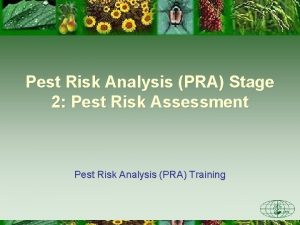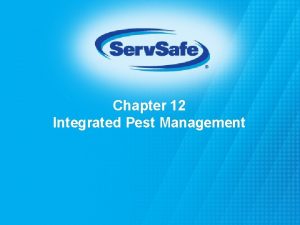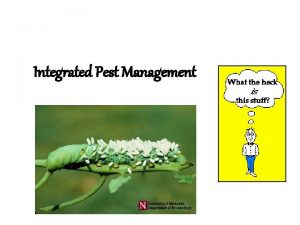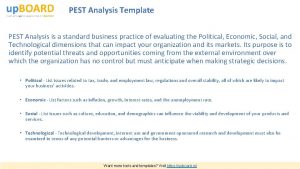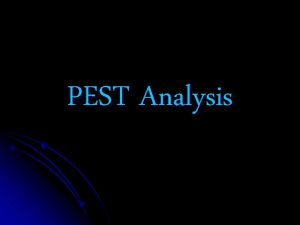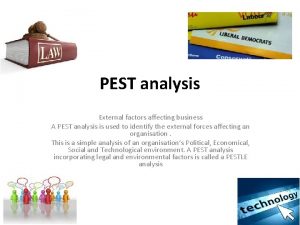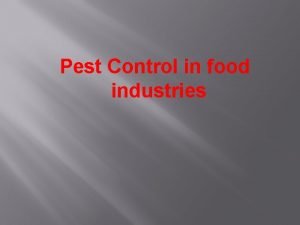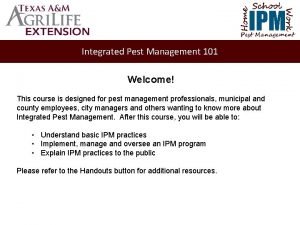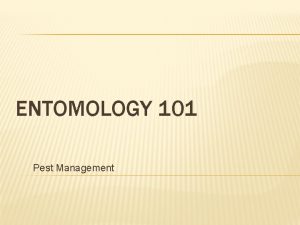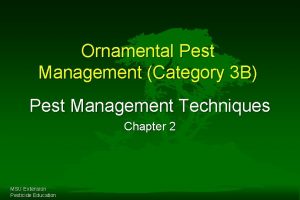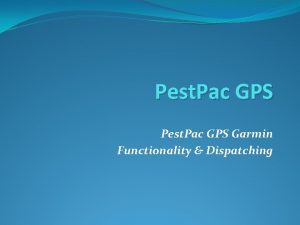KEY PEST GROUPS Lesson 3 of 3 SelfGuided



























- Slides: 27

KEY PEST GROUPS Lesson 3 of 3 Self-Guided Education Module 1

Learning Objectives 2 1. How to identify key exterior and landscape pest groups, including: a. Biting and stinging pests b. Flies c. Ants d. Cockroaches Norway rat - Dawn H. Gouge, e. Rodents University of Arizona f. Wood-destroying insects g. Common weeds

Stinging Pests 3 Yellowjacket Honey bee Baldfaced hornet Paper wasp Fire ant – Robert La. Morte, University of Arizona Scorpion – Dawn H. Gouge, University of Arizona

Biting and Stinging Pests 4 q q Yellowjackets, hornets and paper wasps are both beneficial and problematic They are important predators and scavengers, helping to manage pests and recycle organic materials, but they can also sting humans and pets Yellowjackets and paper wasps can sting repeatedly, while a bee can sting only once Multiple stings from wasps are common because they aggressively defend their nest when they are disturbed

Biting and Stinging Pests Continued 5 q q Fire ants are notorious for their stinging behavior, they respond rapidly and aggressively to any disturbance of the colony or to a food source Fire ants can sting repeatedly The identifying characteristics of a fire ant colony include an earthen nest and polymorphic workers (workers are obviously a mix of different sizes) There are native and Fire Ant Pest and Diseases Image introduced species of fire ants Library, bugwood. org

Biting and Stinging Pests Continued 6 Fire ants are one of very few ants that can pose a serious risk to students and school personnel q They will forage indoors if a food or water source is available, but generally are outdoor challenges largely in turf areas q Red imported fire ants require a specific management plan, ask your local extension agency for tips and advice q Most native species of fire ants can be discouraged by improving turf health, and remediating colonies when necessary using q

Biting and Stinging Pests Continued 7 q Stings of fire ants, bees and wasps may cause allergic reactions in some individuals, a serious health threat that requires immediate medical attention Red imported fire ants

Other Ants 8 In general, ants become pests when they invade buildings in search of food or shelter q It is often very difficult and not desirable to eliminate most ants from their outside habitat, so management efforts should aim at preventing ants from invading structures q Many species of ants help to aerate the soil and facilitate nutrient recycling q Harvester ants – Alex Wild, alexanderwild. com

Other Ants 9 Thus, the first step in managing ants is proper identification, since many types of ants may be beneficial and not cause problems q Additionally identification is critical because most ants differ in their habits, food preferences and require different management strategies for effective Pavement Ant control Joseph Berger, bugwood. org q

Flies 10 House flies, dump flies, bottle flies, flesh flies and others that breed in garbage and/or animal feces generally are referred to as filth flies q Filth flies are not aggressive and do not bite q Flies that enter cafeterias and kitchens can carry bacteria and other microbes from garbage and other areas and can contaminate food, utensils and food q

Cockroaches 11 Except for size and markings, cockroaches are generally similar in appearance: all species are flattened, oval -shaped insects with long legs and antennae q Their heads are tucked under and most have obvious hind “cerci” q The most common are German, brown-banded, American, and oriental cockroaches – cockroaches Dawn H. Gouge, q

German cockroaches Continued American cockroach 12 Oriental cockroach Turkestan cockroach – Dawn H. Gouge, University of Arizona Brownbanded cockroach Kansas Department of Agriculture, Bugwood. org

Cockroaches Continued 13 In general, cockroaches like to squeeze into warm cracks and crevices, but the places they inhabit differ from one species to another q German cockroaches prefer warm and wet environments like kitchens, while brownbanded cockroaches are most often found in drier classroom and office areas q American and oriental cockroaches are generally found where there is high q

German Cockroaches 14 q German cockroaches produce allergens that can trigger asthma symptoms in sensitive individuals German Cockroach Clemson University - USDA Cooperative Extension Slide Series, bugwood. org

Rodents 15 Rats and mice often enter schools and warehouses in search of food and shelter q The most common rodent pests are the commensal rats and mice q They include the roof rat, Norway rat and house mouse q Rats and mice consume or contaminate large quantities of food and damage structures, stored clothing and documents, and can cause a great deal of damage to computer and electrical systems due to their habit of chewing wires q

Rodents Continued 16 Norway rat Roof rat – Larry Jon Friesen Copyright © 1995 -2016 UC Regents House mouse

Wood-destroying Insects 17 Carpenter Ants q Carpenter ants are cavity dwellers q They establish nests in wall voids and spaces in structures usually as satellite colonies associated with larger external colonies associated with tree stumps q Inside they prefer weakened, damp or rotting wood and insulation materials (check Carpenter ant - David Cappaert, Michigan State University, for water leaks)

Wood-destroying Insects Continued 18 Carpenter Ants q Carpenter ants do not actually consume the wood they excavate, they tunnel through it and nest in it q They are large ants and can bite and spray formic acid, but they do not Carpenter ant - Susan Ellis, bugwood. org

Wood-destroying Insects Continued 19 Termites q There are several types of termites including dry wood and subterranean q Termites are social insects that live in colonies q An established colony can exist in a building for years and can consist of thousands or millions of Eastern subterranean termites - Phil Sloderbeck, Kansas State University, Bugwood. org

Bark Beetles and Wood Borers 20 Most often attack weakened, Metalic wood-boring beetle - Johnny N. Dell, Bugwood. o injured or dying trees q Burn or destroy infested wood so surrounding trees are not affected (some survive chipping) q Bark beetles and wood borers bore through the bark of trees - Peeling off a portion of infested bark to reveal the pattern of the beetle galleries (tunnels chewed by adults q

Wood-destroying Insects Continued 21 Powderpost Beetles q Are wood-boring creatures which can bore in wood products manufactured from hardwoods q As their name suggests, powderpost beetles change the wood they eat to a fine powder or dust Powderpost beetle - Pest and Diseases Image Library,

Common Weeds 22 It is important to accurately identify the most common weed species on your school grounds in order to determine appropriate management methods q Knowing the scientific name of the weed makes it much easier to obtain information from q Russian-thistle Utah State University Archive, Utah State University, bugwood. org

Annual Weeds 23 q q q Annual weeds are the most common weed group In general they have a rapid life cycle that requires a minimum of water and nutrients Some can produce more than 20, 000 seeds per plant Crab Grass James H. Miller & Ted Most annual weeds are known as Bodner, Southern summer annuals, they germinate in Weed Science spring, grow to maturity during summer, Society, bugwood. org and die by fall or winter Examples: prostrate spurge, purslane, crabgrass and

Biennial Weeds 24 q q Biennials grow during the spring, summer, and fall of their first year, survive the winter, Wild Carrot and flower during the next Ohio State Weed Lab growing season Archive, The Ohio State University, bugwood. org Biennials may germinate at any time during the growing season They usually produce a radial cluster (rosette) of leaves lying close to the soil during the first season In the second year they produce flower stalks using food stored from the first season’s growth, then they produce seeds, and die Examples: wild carrot, common mullein, musk thistle

3. Perennial Weeds 25 Perennial weeds live more than two years q Perennials spread by seeds and vegetative means such as bulbs, rhizomes, tubers or stolons Yarrow John Ruter, University of q Examples: Georgia, bugwood. org bindweed, plantain, thistle, dock, dandelion, ground ivy, quackgrass, sorrel, clover and yarrow q

Check In! 26 In this lesson you learned 1. Key exterior and landscape pest groups For information on many other key pests see the IPM Coordinator/Pest Management Professional, school nurse, and Landscape and Grounds education lessons

Resources 27 Green, T. A. , D. H. Gouge, J. A. Hurley, M. L. Lame and M. D. Snyder. (2014). School IPM 2020: A Strategic Plan for Integrated Pest Management in Schools in the United States. How to Develop an Integrated Pest Management (IPM) Policy and Plan for Your School District. PENN STATE. Retrieved from http: //extension. psu. edu/pests/ipm/schools/facilitiesmanagers/r esourcespaschools/faq/ipmschoolplan How to Do… IPM at School A How to Manual for New Jersey schools. New Jersey Department of Environmental Protection Pesticide Control Program http: //www. state. nj. us/dep/enforcement/pcp/bpc/ipm/How_to_D o_IPM. pdf New Jersey Department of Environmental Protection Pesticide Control Program. How to Do… IPM at School A How to Manual for New Jersey Schools. Retrieved from http: //www. state. nj. us/dep/enforcement/pcp/bpc/ipm/How_to_D o_IPM. pdf
 How are ethnic groups and religious groups related
How are ethnic groups and religious groups related Lesson outline lesson 2 aquatic ecosystems answer key
Lesson outline lesson 2 aquatic ecosystems answer key Weather forecasts lesson 3 outline answers
Weather forecasts lesson 3 outline answers Physical properties lesson 2
Physical properties lesson 2 Lesson 1 thermal energy and the behavior of matter
Lesson 1 thermal energy and the behavior of matter Climates of earth lesson 1 answer key
Climates of earth lesson 1 answer key Lesson 2 measurement and scientific tools answer key
Lesson 2 measurement and scientific tools answer key Lesson outline lesson 2 the muscular system answer key
Lesson outline lesson 2 the muscular system answer key Lesson outline lesson 2 wave properties answer key
Lesson outline lesson 2 wave properties answer key The sun-earth-moon system worksheet answers lesson 1
The sun-earth-moon system worksheet answers lesson 1 Lesson 1 introduction to waves
Lesson 1 introduction to waves Key partner adalah
Key partner adalah Business model canvas tripadvisor
Business model canvas tripadvisor Ethnic groups cloze notes 1 answer key
Ethnic groups cloze notes 1 answer key Section 28-2 groups of arthropods answer key
Section 28-2 groups of arthropods answer key Chapter 10 comparing two populations or groups crossword
Chapter 10 comparing two populations or groups crossword Get to know myplate food groups answer key
Get to know myplate food groups answer key Build a healthy plate worksheet answers
Build a healthy plate worksheet answers Rodent control teton county
Rodent control teton county Turfgrass pest management (category 3a practice test)
Turfgrass pest management (category 3a practice test) Szgyf fővárosi kirendeltség
Szgyf fővárosi kirendeltség Dewey pest control
Dewey pest control Pest matrica
Pest matrica Pestle analiza
Pestle analiza Pest control herron
Pest control herron Pest control operators of california
Pest control operators of california Pest political economic social technological
Pest political economic social technological ülker swot analizi
ülker swot analizi














